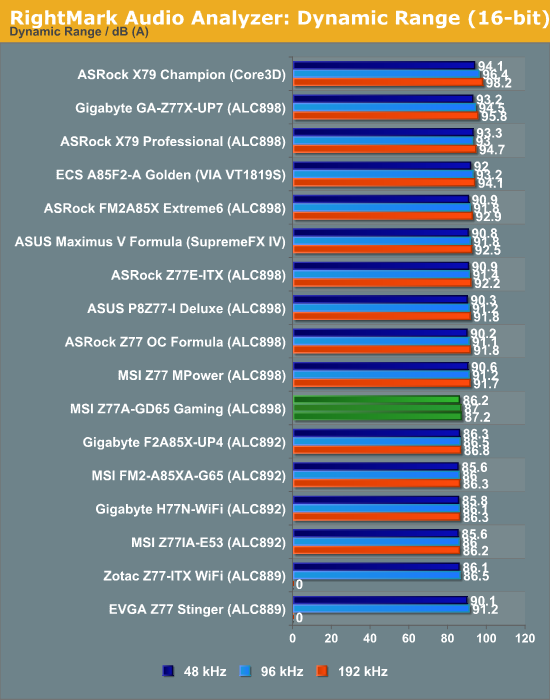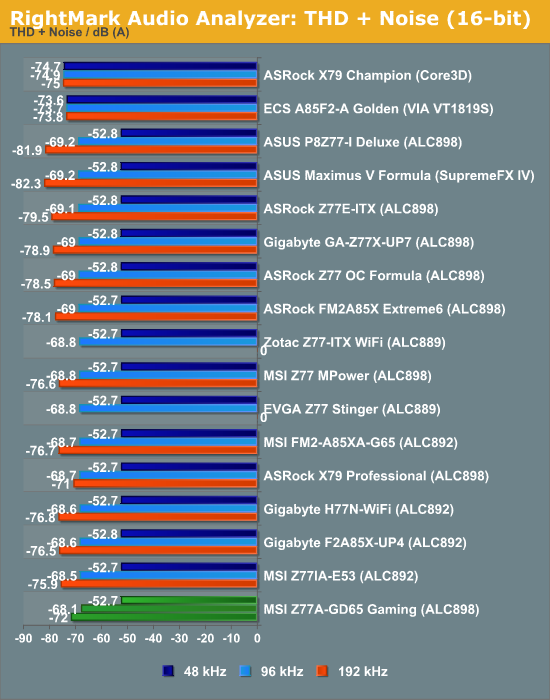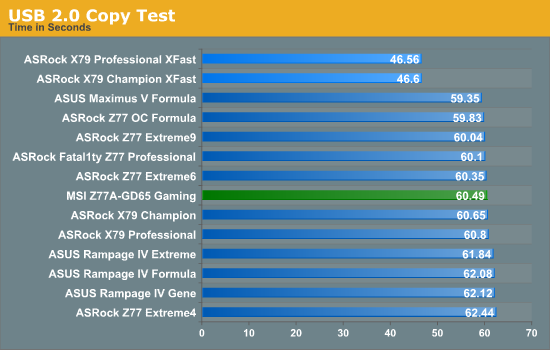MSI Z77A-GD65 Gaming Review
by Ian Cutress on April 18, 2013 12:00 PM EST- Posted in
- Motherboards
- MSI
- Z77
Rightmark Audio Analyzer 6.2.5
In part due to reader requests, we are pleased to include Rightmark Audio Analyzer results in our benchmark suite. The premise behind Rightmark:AA is to test the input and output of the audio system to determine noise levels, range, harmonic distortion, stereo crosstalk and so forth. Rightmark:AA should indicate how well the sound system is built and isolated from electrical interference (either internally or externally). For this test we connect the Line Out to the Line In using a short six inch 3.5mm to 3.5mm high-quality jack, turn the OS volume to 100%, and run the Rightmark default test suite at 48 kHz, 96 kHz and 192 kHz. We look specifically at the Dynamic Range of the audio codec used on board, as well as the Total Harmonic Distortion + Noise.


For an ALC898 chip on a gaming motherboard, the audio solution performs quite poorly. Initially my test had interchannel leakage, caused by SoundBlaster being enabled. While disabling this improved the test, the final results are a bit of a shock, being down in output and distortion compared to the competition.
USB 3.0 Backup
For this benchmark, we run CrystalDiskMark to determine the ideal sequential read and write speeds for the USB port using our 240 GB OCZ Vertex3 SSD with a SATA 6 Gbps to USB 3.0 converter. Then we transfer a set size of files from the SSD to the USB drive using DiskBench, which monitors the time taken to transfer. The files transferred are a 1.52 GB set of 2867 files across 320 folders – 95% of these files are small typical website files, and the rest (90% of the size) are the videos used in the WinRAR test.


MSI does well in terms of absolute USB 3.0 speed, although we have no extra controllers to compare. It happily makes a change from older MSI models that were ~20% slower in USB 2.0.
DPC Latency
Deferred Procedure Call latency is a way in which Windows handles interrupt servicing. In order to wait for a processor to acknowledge the request, the system will queue all interrupt requests by priority. Critical interrupts will be handled as soon as possible, whereas lesser priority requests, such as audio, will be further down the line. So if the audio device requires data, it will have to wait until the request is processed before the buffer is filled. If the device drivers of higher priority components in a system are poorly implemented, this can cause delays in request scheduling and process time, resulting in an empty audio buffer – this leads to characteristic audible pauses, pops and clicks. Having a bigger buffer and correctly implemented system drivers obviously helps in this regard. The DPC latency checker measures how much time is processing DPCs from driver invocation – the lower the value will result in better audio transfer at smaller buffer sizes. Results are measured in microseconds and taken as the peak latency while cycling through a series of short HD videos - under 500 microseconds usually gets the green light, but the lower the better.

The MSI DPC results are great, coming in under 200 microseconds easily. While during our test it hit a peak of 87, I noticed that when network activity was going on (I accidentally left Google Drive enabled) this would raise the DPC maximum to 178, which is still quite good.










37 Comments
View All Comments
ZoeAnderson24 - Monday, April 22, 2013 - link
before I saw the receipt for $6106, I did not believe that my friend actualy erning money in there spare time from there pretty old laptop.. there aunt has done this for only 17 months and at present paid the morgage on there villa and got themselves a Mazda. read more at, All29.comCHECK IT OUTgeokilla - Tuesday, April 23, 2013 - link
This motherboard ahs been on the market for a year and you say it's a new release...? Fail.geokilla - Tuesday, April 23, 2013 - link
Oh I missed a section. Nvmpandemonium - Tuesday, April 23, 2013 - link
Maybe it's just me, but I was expecting a lot more gaming benchmarks for a gaming MoBo.deegee - Sunday, April 28, 2013 - link
Not bad features for the price, but as mentioned in the article not much more than a stock board.Thanks, but I will stick with my ASUS ROG components.
Rob94hawk - Thursday, May 9, 2013 - link
Glad I didn't swap my blue MSI Z77A-GD65 for the gaming version. Other than the NIC and the nice color scheme it doesn't have anything to warrant a swap.PCgamerblogspot - Sunday, December 22, 2013 - link
I think you're being a little harsh on the board, MSI makes great boards and this one is no different. I own this board and although it not going to break any world records what it will do is provide a solid, stable, platform for you to build your PC off of. Its got good features and it's a (reasonably) good OC board. All in all I'm happy with it.